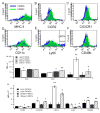PPAR gamma is highly expressed in F4/80(hi) adipose tissue macrophages and dampens adipose-tissue inflammation
- PMID: 19423085
- PMCID: PMC2706276
- DOI: 10.1016/j.cellimm.2009.04.003
PPAR gamma is highly expressed in F4/80(hi) adipose tissue macrophages and dampens adipose-tissue inflammation
Abstract
Macrophage infiltration into adipose tissue is a hallmark of obesity. We recently reported two phenotypically distinct subsets of adipose tissue macrophages (ATM) based on the surface expression of the glycoprotein F4/80 and responsiveness to treatment with a peroxisome proliferator-activated receptor (PPAR) gamma agonist. Hence, we hypothesized that F4/80(hi) and F4/80(lo) ATM differentially express PPAR gamma. This study phenotypically and functionally characterizes F4/80(hi) and F4/80(lo) ATM subsets during obesity. Changes in gene expression were also examined on sorted F4/80(lo) and F4/80(hi) ATM by quantitative real-time RT-PCR. We show that while F4/80(lo) macrophages predominate in adipose tissue of lean mice, obesity causes accumulation of both F4/80(lo) and F4/80(hi) ATM. Moreover, accumulation of F4/80(hi) ATM in adipose tissue is associated with impaired glucose tolerance. Phenotypically, F4/80(hi) ATM express greater amounts of CD11c, MHC II, CD49b, and CX3CR1 and produce more TNF-alpha, MCP-1, and IL-10 than F4/80(lo) ATM. Gene expression analyses of the sorted populations revealed that only the F4/80(lo) population produced IL-4, whereas the F4/80(hi) ATM expressed greater amounts of PPAR gamma, delta, CD36 and toll-like receptor-4. In addition, the deficiency of PPAR gamma in immune cells favors expression of M1 and impairs M2 macrophage marker expression in adipose tissue. Thus, PPAR gamma is differentially expressed in F4/80(hi) versus F4/80(low) ATM subsets and its deficiency favors a predominance of M1 markers in WAT.
Figures








Similar articles
-
Loss of PPAR gamma in immune cells impairs the ability of abscisic acid to improve insulin sensitivity by suppressing monocyte chemoattractant protein-1 expression and macrophage infiltration into white adipose tissue.J Nutr Biochem. 2008 Apr;19(4):216-28. doi: 10.1016/j.jnutbio.2007.02.010. Epub 2007 Jul 6. J Nutr Biochem. 2008. PMID: 17618105
-
Aberrant accumulation of undifferentiated myeloid cells in the adipose tissue of CCR2-deficient mice delays improvements in insulin sensitivity.Diabetes. 2011 Nov;60(11):2820-9. doi: 10.2337/db11-0314. Epub 2011 Sep 16. Diabetes. 2011. PMID: 21926275 Free PMC article.
-
Macrophage alternative activation confers protection against lipotoxicity-induced cell death.Mol Metab. 2017 Oct;6(10):1186-1197. doi: 10.1016/j.molmet.2017.08.001. Epub 2017 Aug 7. Mol Metab. 2017. PMID: 29031719 Free PMC article.
-
Cellular and molecular players in adipose tissue inflammation in the development of obesity-induced insulin resistance.Biochim Biophys Acta. 2014 Mar;1842(3):446-62. doi: 10.1016/j.bbadis.2013.05.017. Epub 2013 May 22. Biochim Biophys Acta. 2014. PMID: 23707515 Free PMC article. Review.
-
Adipose tissue macrophages.Immunol Lett. 2007 Oct 15;112(2):61-7. doi: 10.1016/j.imlet.2007.07.003. Epub 2007 Jul 31. Immunol Lett. 2007. PMID: 17719095 Review.
Cited by
-
CX3CR1 deficiency does not influence trafficking of adipose tissue macrophages in mice with diet-induced obesity.Obesity (Silver Spring). 2012 Jun;20(6):1189-99. doi: 10.1038/oby.2012.7. Epub 2012 Jan 17. Obesity (Silver Spring). 2012. PMID: 22252034 Free PMC article.
-
Conjugated linoleic acid ameliorates inflammation-induced colorectal cancer in mice through activation of PPARgamma.J Nutr. 2010 Mar;140(3):515-21. doi: 10.3945/jn.109.115642. Epub 2010 Jan 20. J Nutr. 2010. PMID: 20089779 Free PMC article.
-
Changes in adipose tissue macrophages and T cells during aging.Crit Rev Immunol. 2014;34(1):1-14. doi: 10.1615/critrevimmunol.2013006833. Crit Rev Immunol. 2014. PMID: 24579699 Free PMC article. Review.
-
The effect of class II transactivator mutations on bleomycin-induced lung inflammation and fibrosis.Am J Respir Cell Mol Biol. 2011 Jun;44(6):898-905. doi: 10.1165/rcmb.2009-0416OC. Epub 2010 Aug 12. Am J Respir Cell Mol Biol. 2011. PMID: 20705943 Free PMC article.
-
Expression of PPAR γ in intestinal epithelial cells is dispensable for the prevention of colitis by dietary abscisic acid.ESPEN J. 2012 Oct 1;7(5):e189-e195. doi: 10.1016/j.clnme.2012.07.002. ESPEN J. 2012. PMID: 23814701 Free PMC article.
References
-
- Ogden CL, Carroll MD, Curtin LR, McDowell MA, Tabak CJ, Flegal KM. Prevalence of overweight and obesity in the United States, 1999-2004. JAMA. 2006;295:1549–55. - PubMed
-
- Flegal KM, Graubard BI, Williamson DF, Gail MH. Cause-specific excess deaths associated with underweight, overweight, and obesity. JAMA. 2007;298:2028–37. - PubMed
Publication types
MeSH terms
Substances
Grants and funding
LinkOut - more resources
Full Text Sources
Other Literature Sources
Medical
Research Materials
Miscellaneous

